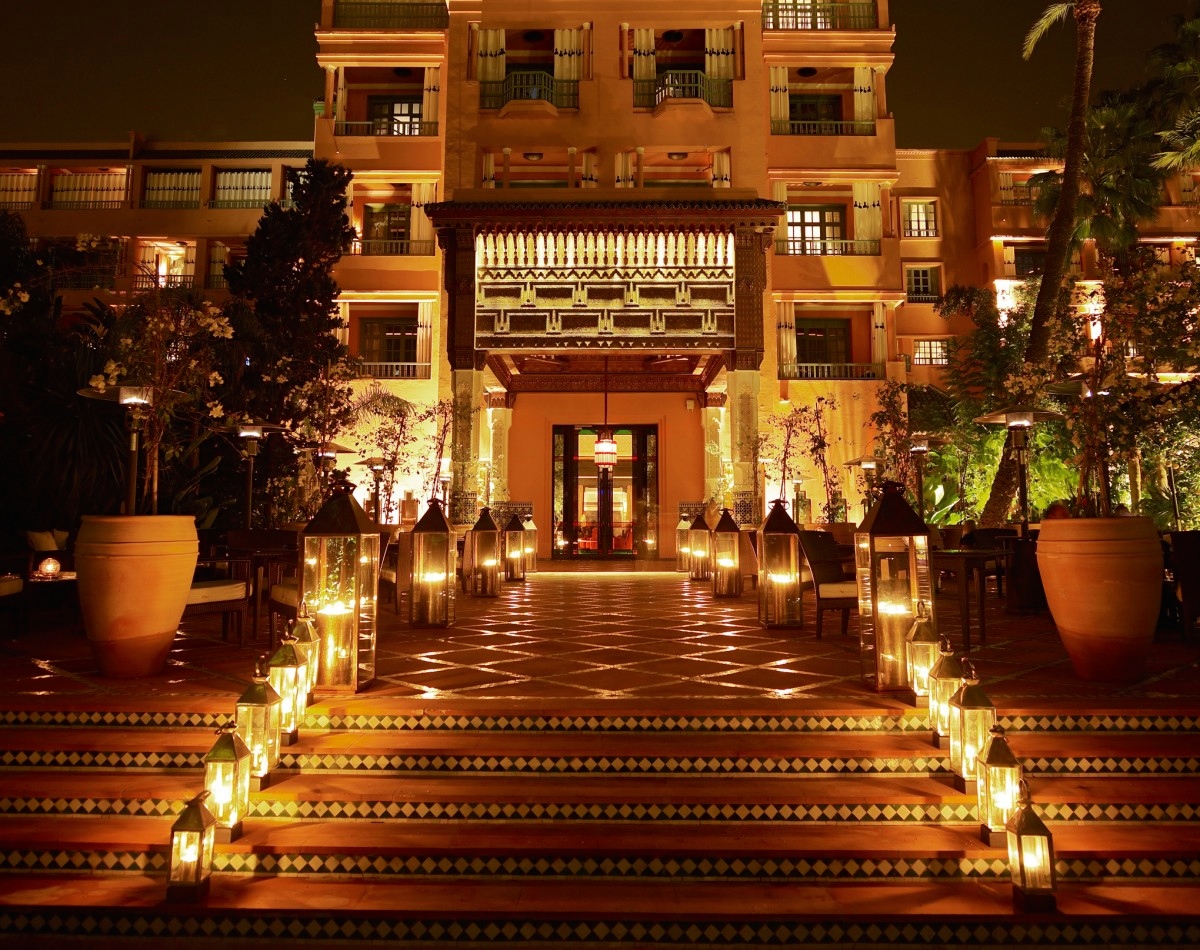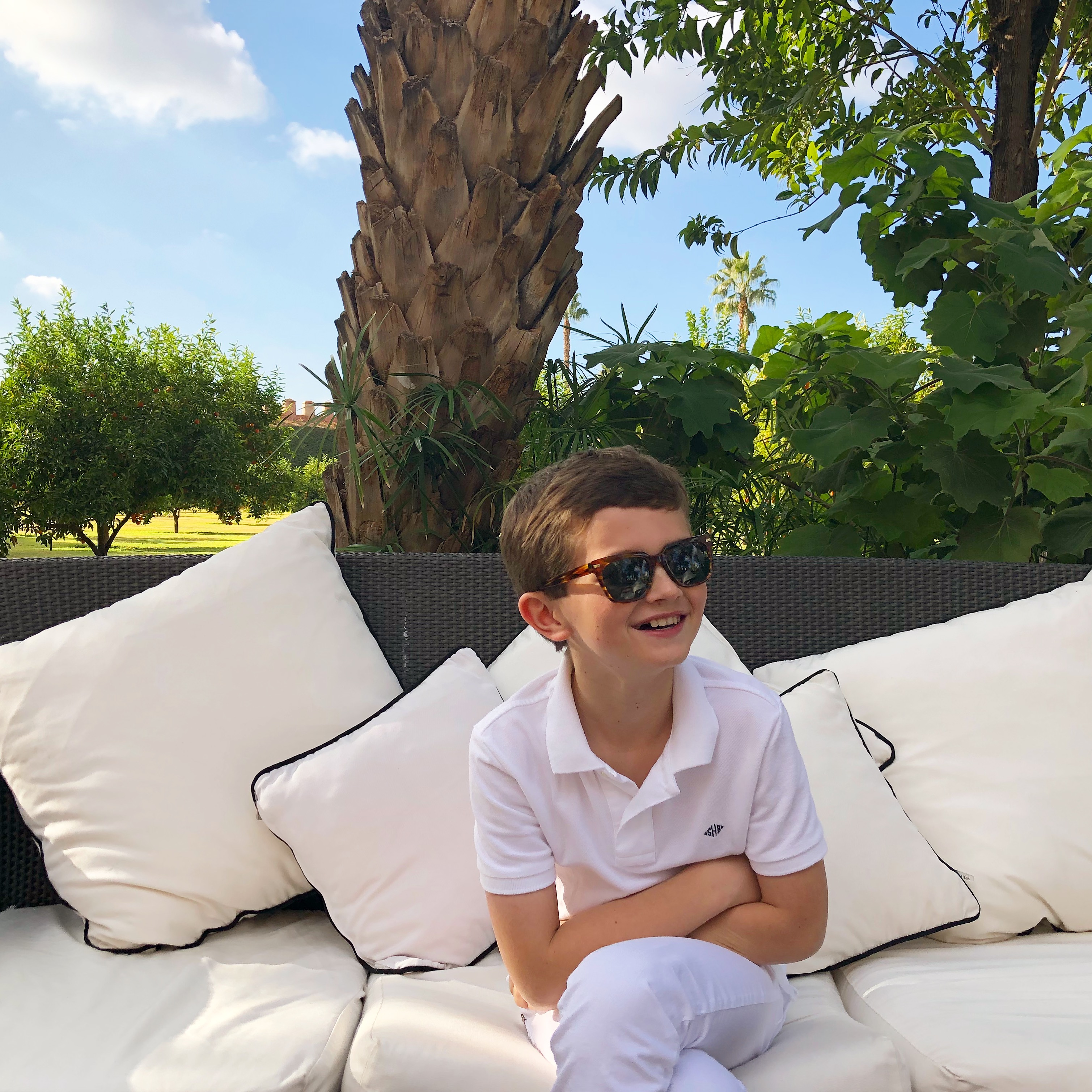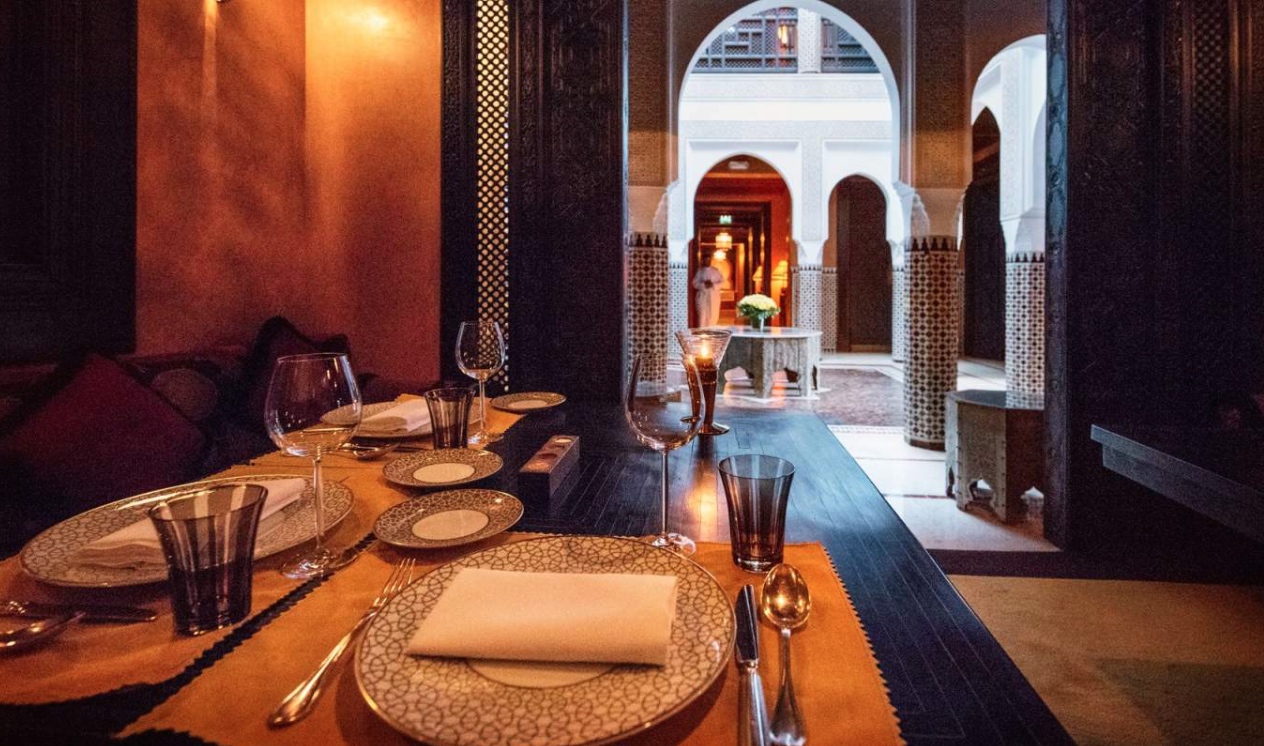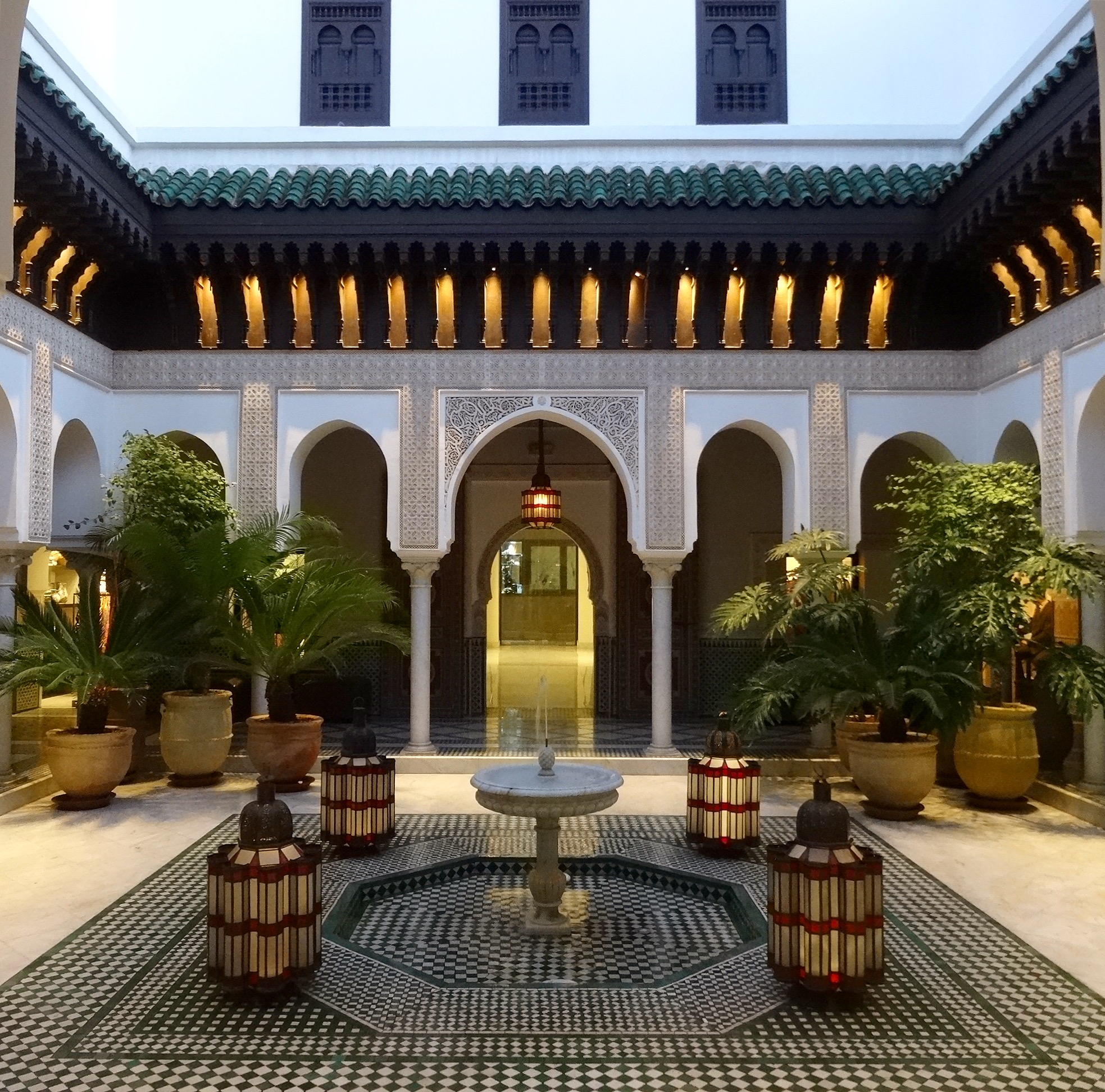New KDHamptons Travel Diary: The Ultimate Arabian Adventure in Marrakech

KDHamptons travel & lifestyle contributor Kim Hopkins has been exploring the globe with her nine year-old son Brady since he was a baby. Being centrally located in Abu Dhabi for nearly a decade, (eight years for Brady), traveling east or west was convenient, taking them to locations near and far, from Istanbul, India and Italy to Bangkok, Singapore and Bali. Brady has been to nearly 30 countries and five continents. Kim shares their latest adventure to the ochre city of Marrakech, Morocco in this NEW KDHamptons Travel Diary, below.
Spending so much time in the Middle East, we love Arabian hospitality and culture. We’ve been back in the U.S. for a year now, so we wanted our first overseas trip to be a blend of the new and old, exotic and familiar. So off to Morocco we went.
“You know the trip’s going to be great when there’s a Range Rover with WiFi,” said Brady, as we settled into the back seat of La Mamounia’s SUV in Casablanca, embarking on the two and a half-hour drive to Marrakech. He then greeted the driver: “As-salamu alaykum!” (the standard Muslim greeting that means ‘Peace be upon you’). “Wa-alaykum as-salam,” replied jovial Mohammed, surprised and delighted to hear his native tongue.

Traveling with my son has been the greatest gift and best learning experience for him and for me. If I could give parents one piece of travel advice, it’s this: Don’t sit on a beach. Take your children to a foreign country where English isn’t the first language; eat food they’ve never seen, have them buy things in the local currency, and visit places of historical significance. They’ll have a leg up before they even start school.
Marrakech is a labyrinth of the mystical, enchanting and historic; the perfect blend of African, Arabian and European cultures. Founded nearly 1000 years ago and located on the edge of the Sahara and at the foot of the snow-capped Atlas mountains, the Unesco Heritage is divided into two distinct parts: the Medina (the historical city), and the modern European district called Gueliz or Ville Nouvelle. The Medina is a maze of meandering passageways, shops and riads. Gueliz has modern restaurants, villas and shops as well as big brand stores.

Where to Stay:
I’ve wanted to stay at La Mamounia (above) for as long as I can remember, but hadn’t made it here until now. It was a dream come true! The legendary palace, which opened in 1923, is in the heart of the old city, within easy walking distance to the medina. The hotel is part of Moroccan history with a colorful tapestry of stories and tales from its famous guests such as Charlie Chaplin and Marlene Dietrich. The Arabic-Andalusian architecture will take your breath away: Zellige tile, Arabesque sculptures, rich velvet fabrics, flowing fountains and abundant gardens are intoxicating.

Sir Winston Churchill spent many winters here, strolling the grounds and painting as the sun set over the Atlas mountains. He told Franklin D. Roosevelt: La Mamounia is “the most lovely spot in the whole world.” Fittingly, Churchill has a luxurious suite named after him, (with his named spelled in Arabic over the bed), as well as the chic and elegant Churchill bar on the main level.

The service at La Mamounia was sublime. One night feeling jet-lagged, Brady wanted their delicious porridge, usually only served at breakfast. No problem…the chef made it especially for him and it was at our room in 15 minutes. The suites at La Mamounia offer one bedroom, a living room, a separate shower and claw-foot bathtub, as well as a powder room for your guests.

One of our favorite days at La Mamounia: A stroll through the vast gardens (20 acres!), and a delicious gelato from Le Menzeh, nicknamed “the king’s sweet shop,” surrounded by olive, orange and prickly pear trees. Heaven.

The colors, fragrances and sounds of the nearly 100 year-old enchanted garden at La Mamounia have attracted famous guests from Sir Winston Churchill and Charlton Heston to Princess Caroline of Monaco and The Rolling Stones. There are 5000 rose bushes, 700 orange trees, 21 species of cactus, bougainvillea, palms, lemon trees and jacarandas, to name a few. This amazing view is from our suite overlooking the snow-capped Atlas mountains.

WHERE TO DINE:

L’Italien (at La Mamounia): With rich crimson banquets, stained-glass windows, and silk brocade walls by Maison Prelle, L’Italien was our favorite restaurant in Marrakech. Two-star Michelin chef Don Alfonso serves the most delicious truffle spaghetti, burrata, risotto and poached sea bream, accompanied by the best Moroccan rose’ (try the Perle Grise–de Mogador). Happy (and slightly embarrassed) to say we ate there five times during the week. It’s delicious and the wait staff is so kind and friendly we loved coming back!!! Open for lunch and dinner; inside La Mamounia.
Dar Moha (81, Rue Dar El Bacha): Enjoy a traditional Moroccan lunch at Dar Moha, (below), located in a turn-of-the-century riad once owned by Pierre Balmain.


Le Marocain (at La Mamounia, below): For a truly Moroccan dining experience, don’t miss Le Marocain for local flavors served in classic Moroccan tagines. With its riad concept, the restaurant is set amid palm and olive trees, and tables are tucked in discrete alcoves creating an intimate atmosphere.

Mint tea is everywhere in Morocco, and is offered as a sign of hospitality and friendship. Poured high above the glass to aerate the tea, it is known for having many healthy benefits, from relieving symptoms of cold and flu to serving as a powerful antioxidant. The essential ingredient, Borji mint, is grown here in La Mamounia’s vegetable garden.

A Sweet Treat: Newly opened in December, and the first one in Morocco and Africa, a Pierre Hermé boutique is now at La Mamounia. Named World’s Best Pastry Chef in 2016 by the World’s 50 Best Restaurants Academy, Hermé has also taken the reigns in the hotel’s pastry kitchen, serving new creations and classics at the house restaurants. While we loved the colorful macaroons, the decadent chocolate cake was to die for!

Where to Shop in Marrakech:

The best money you will spend in Marrakech is on a good guide to help you navigate the vast medina, the famous souk surrounding the historic main square called Jemaa el-Fna. At only $25 USD for three hours, a guide will give you the lay of the land, point out historical sites and lead you to the best shops. Do a bit of research before you go and have some idea of what you want to buy, or just follow in our footsteps!
Finding a guide: Your hotel can recommend a trusted source, or you can use our amazing guide, Hatim Hatiman, recommended by La Mamounia. At 6’6″ he looks more like a stylish bodyguard in his custom Moroccan-blue jacket, but he is a wealth of knowledge, and will bring you to secret boutiques and help negotiate prices, as he knows everyone. (He’s also a great deterrent from overzealous shop owners along the route.) Email to reserve ahead of your visit: hatim@hatimhatiman.com, or USA +1 424 3547586. Currency is the Moroccan dirham, (one MAD is a little more than $10USD, so it’s easy to remember), and you must negotiate!

Be sure to buy Morocco’s famous Argan Oil from a hotel or reputable shop. What’s offered in the medina is often fake. La Mamounia’s boutique is pictured above (love their kaftans, candles and bath products).

A traditional Moroccan item to shop for is the djellaba (above), a long, loose-fitting robe with a pointed hood called a qob. Mostly made of sheep’s wool for warmth in the winter, there are also lighter versions in cotton for summer weather. The large, baggy hood provides protection from the sun and sand and is also handy as a pocket for groceries. They are sold everywhere, but for the best quality and service, go to Lourika Caftan in Semmarine (medina), a great clothing shop where you can find beautiful caftans for women and velvet jackets for men and boys

Start your shopping on the higher-end section of the medina called Dar al Bacha. There you will find some of the best shops, from antiquities and designer clothing to shoe shops (buy a pair of Morocco’s famous babouche, heelless slippers). Be sure to visit the famous Mustapha Blaoui, (144, Arset Aouzal), an Alladin’s den of all things Moroccan, from furniture and lanterns, to antiques and collectibles. Don’t miss Topolina, a small shop by French designer Isabelle Topolina. They sell dresses, jackets, turbans and the most beautiful shoes that are only about $70USD. For fashion-forward guys, there is also a Topolina men’s shop up the road.

These gorgeous Moroccan sinks found in the medina cost between $30-40 USD. Worth carrying home!
Karim Bouriad (Dar el Bacha No. 2) is a great place to buy the traditional Moroccan djellaba for women and men. They come in many colors and qualities, so be sure to pay attention to the fabric and handiwork. I bought a dark gray version in fine sheep’s wool, with the requisite tassle on the oversized hood, called the qob. The shop also sells linen caftans, bejeweled slippers and stylish jackets. Don’t forget to negotiate!

Other shopping favorites in the medina:
La Perle Fassie Chez Berrada: Your one-stop shopping for Moroccan shoes (babouche) and slippers, all at fixed prices. Men’s, women’s and children’s. 5, Souk El Kabir, Essemarine.
La Porte D’Or: Owner Hakim Lebbar told me Tory Burch buys many of her rugs and collectibles here. The two-story boutique is a shopper’s paradise, with gorgeous vases, camel-bone furniture, mirrors, antiques and one-of-a-kind Berber carpets. 115, Souk Semmarine.
Zirari Mustapha: A tiny unassuming shop in Souk Semmarine, this is the best place to buy the softest children’s and adult pajamas. Ask owner Zirari for the “plus simple” pjs in white or gray. Approx. $20USD!
Norya AyroN: Born in Lille, France and of Algerian origin, designer and owner Norya Nemiche sells beautiful caftans and one-off pieces. 32, Souk El Jeld, Abdelaziz (first floor of Le Jardin restaurant).

A mini-market within the medina, Souk Cherifia (located just off Rue Mouassine and shown below) has many specialty shops displaying beautiful wares from some of Marrakech’s top designers. The workmanship is much better than what’s found in other parts of the medina. Head upstairs to Gypsy Queens by French designer Lalla M., where you’ll find boho dresses and suede bags, colorful jewelry and shoes. Check out pop-artist Hassan Hajjaj‘s shop of stylish wheat-sack babouche, funky jewelry and totes. French designer Sylvie Pissard sells stylish cushions at her shop called Sissimorocco.


Finally, if you tire of bartering in the medina, head to Etablissement Bouchaib, a three-story craft complex of home décor, from rugs and lanterns to camel bone mirrors, art and jewelry. All prices are fixed. 7, Derb Baissi Rue de la Kasbah.
WHERE TO SPA:

After a full day of navigating the medina, we hit Le Spa at La Mamounia for a swim (Brady) and the famous Moroccan Hamman treatment, a multi-step process for rejuvenation and youthfulness (me). Therapeutic black soap is applied, followed by a vigorous scrub, then a ghassoul wrap and a soothing massage to soften the skin. The spa has a wide range of wellness services from massages to hypnosis.


WHAT TO SEE:

Le Jardin Majorelle: No visit to Marrakech is complete without a visit to Le Jardin Majorelle, a forty-year labor of love for French painter Jacques Majorelle. Yves Sant Laurent and Pierre Berge’ first discovered the garden in 1966 and would visit frequently, eventually purchasing the property in 1980, saving the jewel from becoming a new hotel complex. They restored the gardens and lived in Villa Bou Saf Saf, which they renamed Villa Oasis. Opened to the public in the fall of 2017, the ashes of both men are scattered here. Have lunch in the café and then visit some of the nice shops across the street. Les Sens de Marrakech is a lovely boutique with beauty products, perfumes, diffusers and the best room sprays.

Bahia Palace: La Bahia (the beautiful) Palace is a masterpiece of modern Moroccan and Islamic architecture. Built in the late 19th Century by Si Moussa, a former slave who worked his way up to become grand vizier of the sultan, the 150-room palace includes a large court decorated with a central basin surrounded by rooms for the concubines. There is also an impressive riad (shown above), surrounded by lush plants and citrus trees. Most notable is the Zellige tilework, mosaics made from individually chiseled geometric tiles set into a plaster base. This form of Islamic art is one of the main characteristics of Moroccan architecture. A must-see in Marrakech. Entry fee is only $1USD.

Other Top Sights:
When you go to the medina, it’s hard to miss the iconic Koutoubia Mosque, Marrakech’s most well-known landmark, beckoning the faithful to prayer five times a day since the 12th century. Non-Muslims cannot enter, but a quick walk around and photo will do the trick. The 70m (229 ft.) high tower also doubles as a great homing device to get your bearings in the medina and back to your hotel or riad.
Saadian Tombs: Located just outside of the city, this is the resting place of Sultan Ahmed el Mansour and other Saadian royalty. Basically intricately tiled tombs.
Badi Palace: Not much of a palace anymore, here lies the remains of jagged ruins from the lavish 16th century complex of buildings with more than 350 rooms, courtyards, gardens and a large pool. Only go if you’re interested in historical ruins.
Ali ben Youssef Medersa: The inscription over the entrance reads: “You who enter my door, may your highest hopes be exceeded.” Founded in the 14th century, it is arguably the oldest and most important mosque in Marrakech and one of the finest examples of Islamic art. For the best photos, head upstairs to the dormitories and shoot through the small windows overlooking the courtyard.

Places to explore:
Southwest of Marrakech lies the famous Agafay Desert, perfect for camel- and horseback-riding, mountain-biking and ATV adventures. In the spring the arid desert is covered in wheat and wild flowers. Stay the night in a Berber tent and enjoy lunch at La Pause.
Take a day trip to the coastal city of Essaouira, which sits on Morocco’s rugged Atlantic coast. Sit on the beach or explore the port city, with its iconic orange walls, historic sites and markets. (Approx. 2 hrs from Marrakech.)
If you want an authentic Moroccan desert experience, explore the valleys and desert landscapes of Ouarzazate. Either a one- or multi-day excursion, (it’s nearly four hours from Marrakech), you’ll see the Atlas Mountains, sip rose’ at sunset, drive ATVs in the desert, ride a camel or see the UNESCO World Heritage Site of Ait Ben-Haddou.

Helpful Tips:
-Learn a little Arabic to avoid being harassed by vendors. “La..shokran” (No, thanks) is essential.
-Avoid the market square at night and head to the rooftop of one of the restaurants or riads for a bird’s-eye view. Don’t take photos of the snake charmers, dancers or singers unless you are prepared to pay them. They can get aggressive, as this is how they make their money.
-Dress appropriately and cover your shoulders.
-Don’t follow someone who is going to show you the “best shop in Marrakech.” It very well may be, but it will also be owned by his family or friend and he’s getting paid.
-Negotiate your taxi price at the start of the ride or insist the driver turn on the meter.
-There are ATMs all over, including the airport, so no need to exchange money before you go.

**You can follow the travels of Kim and Brady on Instagram (@kimhopkins) (@bradysworld). All photography by Kim Hopkins.

